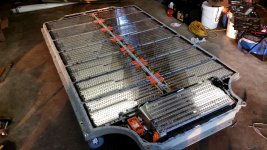jonescg
100 MW
Well its obvious that physical trauma is a bad thing, but this paper describes how the authors took 18650 cells and shook the shit out of them for 100 hours and measured capacity and IR. Holy crap! Double, even quadruple the internal resistance! Capacity was down, but not a long way. Z, Y and Z axis were all used, however I suspect the Z axis might have had the most impact.
http://www.mdpi.com/1996-1073/9/4/255/htm
I wonder if this is due to the fact that the active material (aka jellyroll) is wound around the mandrel, and is not supported by anything other than it's own tension.
Make sure your cells are snug inside their packs!
http://www.mdpi.com/1996-1073/9/4/255/htm
I wonder if this is due to the fact that the active material (aka jellyroll) is wound around the mandrel, and is not supported by anything other than it's own tension.
Make sure your cells are snug inside their packs!


